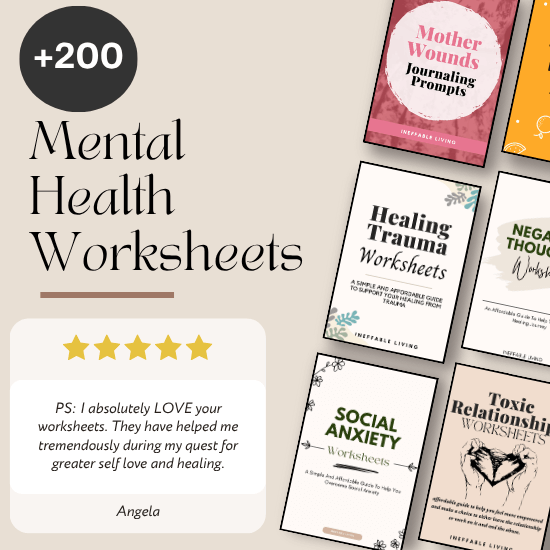Mental health worksheets are everywhere right now — in therapy offices, on social media, and in self-help spaces. But are they just another trend, or are they actually useful for long-term healing?
Let’s break it down.
What Are Mental Health Worksheets?
Mental health worksheets are structured tools designed to help you explore your emotions, thoughts, and behaviors. They’re based on proven psychological approaches like CBT, DBT, and trauma-informed care. They’re not new — therapists have used them for decades.
Mental Health Worksheets: Fad or Fundamental Tool?
In a world full of mental health trends, it’s fair to wonder—are mental health worksheets just another self-help fad, or do they offer something truly lasting? While they may seem trendy due to their rising popularity online, worksheets aren’t a passing craze. They’re grounded in evidence-based therapies and psychological principles that have stood the test of time. In fact, they’re one of the most accessible, practical tools available for real emotional growth. Here’s why they’re more than just a trend.
1. They’re Backed by Proven Therapeutic Approaches
Mental health worksheets are used in structured therapies like Cognitive Behavioral Therapy (CBT), Dialectical Behavior Therapy (DBT), Acceptance and Commitment Therapy (ACT), and trauma-informed care. These aren’t new—they’re long-established, research-supported approaches to healing.
2. Therapists Use Them Every Day
Worksheets aren’t just for social media. Therapists across the world use them to guide clients through complex thoughts, emotional regulation, and behavioral change. They’re clinical tools that happen to be accessible for self-help as well.
Related: Feel Like You Can’t Move Forward? These Worksheets Help You Get Unstuck
3. They Support Lasting Self-Awareness
Unlike fads that promise quick fixes, worksheets encourage self-inquiry, pattern recognition, and deep emotional awareness. These are not short-term solutions—they’re lifelong mental health skills in written form.
4. They Empower Independent Healing
One of the reasons worksheets are so powerful is because they put the tools of reflection and growth directly in your hands. They help people take an active role in their own healing, which increases confidence and personal agency.
5. They Complement, Not Replace, Therapy
Worksheets don’t try to replace therapy—they enhance it. They offer structure between sessions and make therapeutic insights easier to apply in everyday life. That makes them a sustainable tool, not a trendy distraction.
Related: Burned Out and Overwhelmed? These Worksheets Help You Reclaim Your Mental Health
6. They Promote Emotional Consistency
Fads come and go because they rely on novelty. Worksheets help you build consistent habits—like journaling, tracking your thoughts, or identifying triggers—that lead to long-term resilience and emotional stability.
Why People Think They’re Just a Fad
Because they’re more visible now, it’s easy to assume they’re trendy. But popularity doesn’t mean they’re shallow. The real value of worksheets comes from how you use them — not how many you have or how pretty they look.
Related: Carrying Old Wounds? These Worksheets Help You Start Healing Your Trauma
How to Build a Weekly Routine with Mental Health Worksheets?
A worksheet routine doesn’t have to be complicated or time-consuming—it just needs to be consistent and aligned with your needs. Here’s how to build one that works for you.
1. Start with a Clear Intention
Ask yourself: What do I want this routine to support?
Is it managing anxiety, processing emotions, building confidence, or something else? Your answer will guide which worksheets to choose and how often to use them.
2. Pick a Consistent Time
Choose a specific time each week to sit down with your worksheets. This could be:
- Sunday evenings for reflection and planning
- Midweek check-ins to reset
- Friday afternoons to decompress
The key is consistency—make it a non-negotiable part of your self-care.
3. Use a Mix of Worksheet Types
Keep it balanced by rotating through different types of worksheets, such as:
- Emotional check-ins (to track moods and triggers)
- Cognitive tools (to reframe unhelpful thoughts)
- Self-compassion or grounding exercises
- Goal-setting or habit trackers
A mix keeps the process fresh and meets your emotional needs from different angles.
Related: Always Anxious? These Worksheets Can Help You Calm Down Fast
4. Don’t Overload Your Schedule
You don’t need to complete five worksheets a week. One or two is enough if you’re thoughtful and present with them. Quality and reflection matter more than quantity.
5. Reflect on Patterns Each Week
At the end of the week, take five minutes to review your completed worksheets. Ask:
- What am I noticing about myself?
- What helped me feel better?
- What needs more attention next week?
This reflection turns worksheets into a growth tool, not just a habit.
6. Adjust Based on Your Energy
Some weeks, you’ll want something light and grounding. Other weeks, you may be ready to explore deeper issues. Let your emotional bandwidth guide your worksheet choices, and be flexible when needed.
7. Pair It with a Weekly Ritual
Make it enjoyable. Light a candle, brew tea, or sit by a window. Pairing your worksheet time with a soothing ritual trains your brain to associate this practice with calm, self-connection, and intention.
Related: Burned Out and Overwhelmed? These Worksheets Help You Reclaim Your Mental Health

Conclusion
Mental health worksheets aren’t a passing fad. They’re a fundamental tool that helps real people deal with real emotions in a real way. Not because they’re trendy — but because they work.